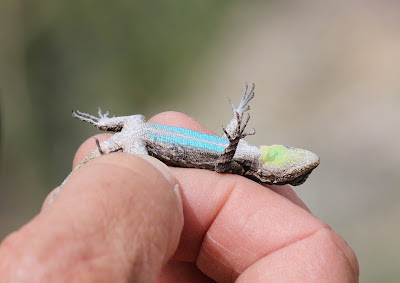 |
| Photo by Ned Harris 3/20/2013 |
Looks like this male Phainopepla has been doing some spring cleaning. That's quite a pile of Desert Mistletoe (Phoradendron californicum) seeds. Great work!
 |
| Photo by Ned Harris 3/20/2013 |
 |
| Photo by Marty Horowitz 3/21/2013 |
 |
| Photo by Marty Horowitz 3/21/2013 |
 |
| Photo by Elaine Padovani 3/22/2013 |
We have a long drain pipe under our driveway (about 100 yards long) that connects to our roof via a scupper and to additional drains in the yard. The drain system is inhabited by at least one gila monster, a scaled lizard, and a desert rattlesnake. I assume that each occupies a different pipe segment in the system but sometimes they are seen together, sunning themselves in the scupper. This is a sure sign of spring! Today [3/22/2013], the saga continues - after being displaced by the rattlesnake earlier, the gila monster came back to claim his spot in the late afternoon warmth and light!
| Photo by Peggy Wenrick 3/18/2013 |
 |
| Photo by Ned Harris 3/20/2013 |
[W]e don't usually see Gila monsters here on our property until monsoon season starts, lo & behold, one showed up yesterday (3/15/2013)!
We were having our old evap cooler replaced... the new unit sits up on metal legs. In between carting stuff back & forth, the workmen found a Gila monster had crawled underneath the new evap cooler. They carefully put the Gila monster in a bucket & brought it to us. I was so happy they were so respectful & careful! After a photo op that really shows how big this one was, we turned it loose away from the house near a very shady palo verde along a small wash that runs through our property. After checking things out with several flicks of its big black tongue, it trundled away into the shade.
Here it is in the bottom of the 5 gallon bucket... we estimated it was about 18 inches long. It looked very healthy, with an obviously very fat tail. If you look carefully at the top of the monster's head, you can see a patch that looks like dirt, but we think it may be old skin about to be shed since its tail had some small, ragged pieces of skin hanging off & its color overall was a bit on the dull side.
 |
| Photos by Marty Horowitz 3/21/2013 |
 |
| Photo by Marty Horowitz 3/21/2013 |
 |
| Photos by Marty Horowitz 3/21/2013 |
 |
| Photo by Marty, Hand by Larry Jones 3/21/2013 |
 |
| Photo by Ned Harris 3/20/2013 |
 |
| Photo by Ned Harris 3/13/13 |
 |
| Photo by Ned Harris 3/13/13 |
 |
| Photo by Ned Harris 3/13/13 |
 |
| Photo by Ned Harris, hands by Margarethe Brummermann 3/13/13 |
 |
| Photo by Ned Harris 3/13/13 |
 |
| Photo by Ned Harris 3/13/13 |
 |
| Photo by Elizabeth Reed 3/13/13 |
 |
| Photo by Ned Harris 3/13/13 |
 |
| Photo by Ned Harris 3/13/13 |
 |
| Photo by Roger Rittmaster 3/7/2013 |
[This] photo is a White-lined Sphinx Moth (Hyles lineata) nectaring on Fairy Duster (Calliandra eriophylla). This was taken at dusk. For the camera buffs who might be interested¸ it was shot with a Nikon D300 camera, through a Tamron 180 mm macro lens, using a SB-900 flash. It was shot in shutter priority at 1/4000 second. Even that’s not enough to freeze the wings of the moth, but I got lucky, as the moth’s wings were almost motionless at the end of a beat.
.jpg) |
| Photo by Roger Rittmaster 3/7/2013 |
[This] pair of Verdins [is] building a nest near the start of the connector trail to the Bear Canyon Road. Someone had told me that only male Verdins build nests, but this pair was definitely doing it together. At one point I saw both the male and female with sticks in their mouths at the same time.
 |
| Photo by Marty Horowitz 3/7/2013 |
 |
| Photo by Roger Rittmaster 3/6/2013 |
 |
| Photo by Marty Horowitz 3/6/2013 |
 |
| Photo by Marty Horowitz 3/6/2013 |
| Photos by Matt Ball |
| Photos by Matt Ball |
| Photos by Matt Ball |